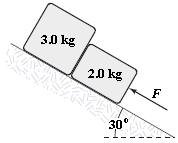The surface of the inclined plane shown is frictionless. If F = 30 N, what is the magnitude of the force exerted on the 3.0-kg block by the 2.0-kg block?

a.
18 N
b.
27 N
c.
24 N
d.
21 N
e.
15 N
a
You might also like to view...
What's a decay chain?
a. a nuclear chain reaction b. one radioisotope decaying into another, which decays into another, and so on c. the triggering of multiple fissions by a single neutron d. none of the above
Ray says that interference effects cannot be observed with visible light because random phase changes occur in time intervals less than a nanosecond. Stacy says that doesn't matter if collimated light from a single source reaches multiple openings. (They are arguing about a light source 50.0 cm away from two 0.0100-mm-wide slits, 2.00 mm apart, with a screen 1.00 m away from the slits.) Which one, if either, is correct, and why?
A. Ray, because the phases at the two slits will be random and different. B. Ray, because it takes light over 3 ns to travel 1.00 m to the screen. C. Stacy, because the difference in time of travel from the source to the slits is no more than about 7 × 10?12 s. D. Stacy, but only if a lens is placed in front of the slits. E. Both, because interference of light never occurs outside a physics lab.
What is the difference in wavelength for spectral lines emitted by hydrogen for transitions from the n = 16 level to the n = 2 level and transitions from the n = 15 level to the n = 2 level? (RH = 1.097 × 10^7 m?1.)
a. 1.0 × 10^?10 m b. 2.0 × 10^?10 m c. 4.1 × 10^?10 m d. 8.1 × 10^?10 m e. 1.6 × 10^?9 m
If the population of a country doubles every 25 years, a 1980 population of 10 million will reach 80 million in the year
a. 2005. b. 2030. c. 2055. d. 2080. e. 2105.